Karl Shuker's Blog, page 28
February 14, 2017
EXPOSING YET ANOTHER FAKE BLACK LION PHOTOGRAPH
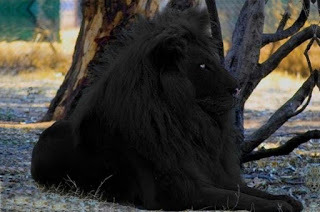 Yet another fake black lion photograph currently circulating online (© owner/creator currently unknown to me, reproduced here on a strictly non-commercial Fair Use basis only)
Yet another fake black lion photograph currently circulating online (© owner/creator currently unknown to me, reproduced here on a strictly non-commercial Fair Use basis only)Several photographs purporting to be of genuine black lions (i.e. melanistic specimens) are presently doing the rounds on the internet, but as I exclusively revealed on ShukerNature quite some time ago (click here and here ) they are all fakes, digitally created from existing photos of normal lions or, in one instance, of a real white lion. Recently, however, I encountered online a black lion photo that I had not previously seen (and which opens this present ShukerNature blog article). So, just like before, I duly investigated it – and indeed, just like before, it duly turned out to be yet another fake.
Using Google Image, I swiftly discovered that this photograph appeared in a sizeable number of websites, but in some of them the photo contained a small yet very telling inscription tucked away within its bottom left-hand corner – Worth1000.com – and, immediately, all became clear. For until it was incorporated within another site, Worth1000.com had been a website long famous for its thematically-based competitions to produce first-class digitally-created/photoshopped images. The inscription present in this black lion photograph thereby confirmed that the latter image had been created and entered for one such competition. Unfortunately however, it has since been erroneously assumed by some websites to be a genuine photo of a genuine black lion.
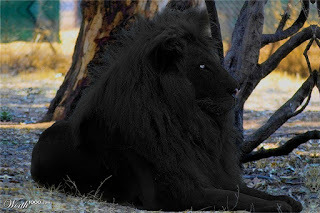 The same black lion photograph, but containing the Worth1000.com inscription, which had been removed from the version that I had first seen online (© owner/creator currently unknown to me, reproduced here on a strictly non-commercial Fair Use basis only)
The same black lion photograph, but containing the Worth1000.com inscription, which had been removed from the version that I had first seen online (© owner/creator currently unknown to me, reproduced here on a strictly non-commercial Fair Use basis only)I have yet to discover the identity of the person who created this photo for the Worth1000.com competition, but once I do I'll add the relevant information here.
All that remained now, therefore, was to trace the original, non-modified lion photograph that had been used as the basis for the modified, black lion photo – and thanks once again to Google Image I was soon able to do this. Interestingly, as in one previous case involving the creation of black lion photos, it proved to be a photo not of a normal lion but of a rare white lion instead (such specimens are seemingly leucistic rather than albinistic, as they possess either blue eyes or normal-coloured golden eyes – click here for more details). The white lion in question was named Letsatsi, housed at the famous Lion and Safari Park in Gauteng, South Africa, and had been photographed by Arno Meintjes. The photo in question appears on numerous websites (including that of Project Noah – click here ), and is included in the visual comparison below on a strictly non-commercial Fair Use basis only, exclusively for the purposes of education and review, alongside the fake black lion photo created from it by person(s) unknown:
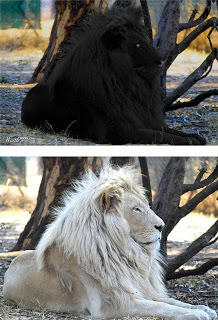 The fake black lion photo (top) alongside the original photo of a real white lion (bottom) (© owner/creator currently unknown to me / © Arno Meintjes – both photographs reproduced here on a strictly non-commercial Fair Use basis only, exclusively for the purposes of education and review)
The fake black lion photo (top) alongside the original photo of a real white lion (bottom) (© owner/creator currently unknown to me / © Arno Meintjes – both photographs reproduced here on a strictly non-commercial Fair Use basis only, exclusively for the purposes of education and review)Another 'black lion photo' case duly solved.
More details concerning purported black lions, as well as white lions, spotted lions, striped lions, green lions, horned lions, winged lions, lion hybrids, and many other leonine anomalies, can be found in my books Mystery Cats of the World and Cats of Magic, Mythology, and Mystery . And to read a poem of mine inspired by the concept of a black lion, click here .
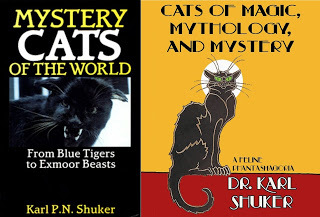
Published on February 14, 2017 17:43
February 7, 2017
WATER CIVET VS AQUATIC GENET, OR MORPHOLOGY VS MOLECULAR BIOLOGY - A TALE OF TANGLED TAXONOMY
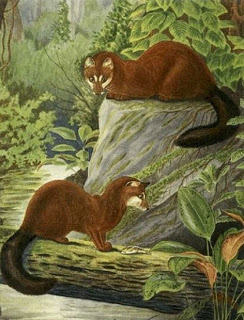 Painting from 1924 of water civets/aquatic genets in their native habitat (public domain/reproduced here on a strictly non-commercial Fair Use basis only)
Painting from 1924 of water civets/aquatic genets in their native habitat (public domain/reproduced here on a strictly non-commercial Fair Use basis only)Originally a civet, nowadays a genet, unrecorded by science until 1913, never studied alive by scientists, and virtually unknown even to the local native people (a rare event indeed!), Genetta (=Osbornictis) piscivora is surely one of the world's most mystifying mammals.
Yet it is an exceedingly handsome, strikingly-coloured creature, with a densely-furred chestnut head and body, a black bushy tail (constituting almost half of the animal's total length of 3 ft), and white facial markings. The type specimen of this secretive viverrid was obtained on 1 December 1913 in a forest stream at Niapu, in what is now the northeastern portion of the Democratic Congo, by Drs James P. Chapin and Herbert Lang during the American Museum of Natural History's Congo Expedition. Six years later, its species was formally described by Dr Joel A. Allen from the museum, who named it Osbornictis piscivora, in honour of Prof. Henry Fairfield Osborn (who was greatly interested in the Congo Expedition), and recording its fish-eating proclivity.
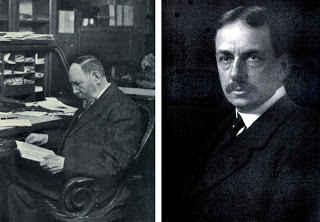 Dr Joel A. Allen (left) and Prof. Henry Fairfield Osborn (right) (public domain)
Dr Joel A. Allen (left) and Prof. Henry Fairfield Osborn (right) (public domain)Although its anatomy suggests that it is most closely related to the genets, this anomalous species was long referred to as the water civet because it exhibits several features markedly at variance with typical genet morphology. Most obvious of these is its vulpine colouration, totally different from the black-and-white coat patterning of spots and bands synonymous with genets. In addition, the soles of its paws are unfurred, its teeth are much weaker and narrower than those of correspondingly-sized genets, its nose is somewhat smaller, its muzzle is shorter, and its overall size rivals that of the giant genet Genettavictoriae, the largest of the typical spotted Genetta species. Consequently, when formally describing and naming it, Allen assigned this novel viverrid to its very own genus, Osbornictis, in which it remained for many decades.
In 2004, however, a team of researchers who had been conducting a molecular-based comparison of several different viverrid genera, including Osbornictis and Genetta, published their findings in a Zoologica Scripta paper, in which they concluded that these two genera were sufficiently closely related for the water civet to be housed within Genetta, as Genetta piscivora. Since then, it has been known colloquially as the aquatic genet.
 My model of this enigmatic species (© Dr Karl Shuker)
My model of this enigmatic species (© Dr Karl Shuker)Most books state that the water civet (or aquatic genet) was totally unknown to the natives prior to its scientific discovery in 1913; this is not true. Along with the holotype, Lang and Chapin also obtained an incomplete specimen (lacking skull, tail, and feet) from a native; and in the local Kibila and Kipakombe languages, it has its own specific name - the esele.
Nevertheless, for the most part it is truly as much a mystery to them as it is to science, with virtually no information available concerning its natural history, and very few museum specimens.
 The type locality of this species (i.e. where its type specimen was obtained), a large forest brook at Niapu, photographed here at the height of the rainy season (public domain)
The type locality of this species (i.e. where its type specimen was obtained), a large forest brook at Niapu, photographed here at the height of the rainy season (public domain)In 1996, however, a major new chapter was written in this species' sparse history, when veteran wildlife film-maker Alan Root announced that he had succeeded in filming a living specimen in its native Congolese habitat, hunting for fishes by gently tapping the water with its paws and then trailing its long white whiskers on the surface to detect any movements. This unique footage formed part of a special one-hour film of Congolese wildlife by Root entitled A Space in the Heart of Africa, which was first screened on British television within the long-running ITV Survival series in July 1996.
This ShukerNature blog article is adapted and updated from my book The Encyclopaedia of New and Rediscovered Animals , the most comprehensive book on this subject ever published.
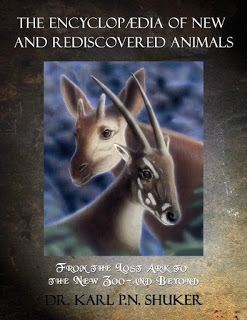
Published on February 07, 2017 12:07
February 3, 2017
UFO-LOGICAL ENCOUNTERS OF THE INSECT KIND?
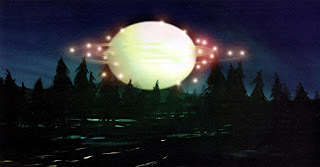 Computer-generated rendition of what a UFO consisting of a large swarm of glowing insects may look like – image produced specifically for my book
Mysteries of Planet Earth
(© Tim Brown/Carlton Books)
Computer-generated rendition of what a UFO consisting of a large swarm of glowing insects may look like – image produced specifically for my book
Mysteries of Planet Earth
(© Tim Brown/Carlton Books)As long ago as the early 1800s, there had been speculation among various scientists that some unusual lights and other luminous objects seen in the sky may have an entomological explanation. To quote one such believer, German astronomer Dr Johann Elert Bode, commenting in 1823:
Fatuous fires, torches, flaming jets and other luminous phenomena have the same character as falling meteorites, of which they differ only by their dimensions. They may also have their origin in dense and heavy evaporations of the lower layers of the air, evaporations that emit a phosphorescent light and to which the wind impresses them movement and casual forms...Sometimes these phenomena are not meteors, but large swarms of luminous insects, who fly often at night.
Even the famous Swiss psychoanalyst Prof. Carl Jung had considered such a prospect, noting in 1961: "I must confess that in reading the numerous UFO relations I also came up with the idea that the characteristic behaviour of UFOs resembles especially that of certain insects".
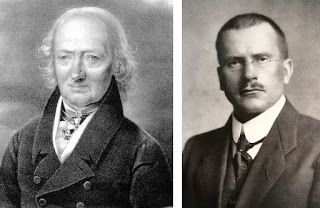 Dr Johann Elert Bode (left) and Prof. Carl Gustav Jung (right) (Wikipedia/public domain)
Dr Johann Elert Bode (left) and Prof. Carl Gustav Jung (right) (Wikipedia/public domain)
Moreover, during the 1960s and 1970s, amateur scientist Norton T. Novitt, a scientific illustrator from Denver, in Colorado, USA, attracted attention from ufologists and entomologists alike by virtue of his own interest in the possibility that certain UFO sightings featured insect swarms that had somehow been rendered luminous. This idea stemmed from a sighting that he had made one day of two glowing winged ants in flight, their apparent luminosity actually constituting reflected sunlight. Some species of ant grow wings and engage in mass nuptial flights at certain times of the year, and as these mating swarms can contain several million insects, they often attain a very considerable size - large enough to resemble glowing orbs in the sky if there is sufficient sunlight to bounce back to earth from the swarms. Even so, luminous UFO sightings made at night could not be explained by this theory - or could they?
As described by Robert Chapman in his book Unidentified Flying Objects (1968), Novitt wondered whether it was conceivable that flying ants could generate their own luminosity (i.e. as distinct from merely reflecting rays of sunlight). To pursue this piquant line of speculation, he attached some winged ants to a ping-pong ball, which in turn was connected by a thin wire to a static generator placed in a darkened room - and sure enough, when the generator was set in motion, the ants' bodies began to glow brightly. Although certainly interesting, such an experiment may appear rather futile at first, because in the natural world (as Chapman drily commented in his own coverage of Novitt's researches) ants are not normally attached to generators!
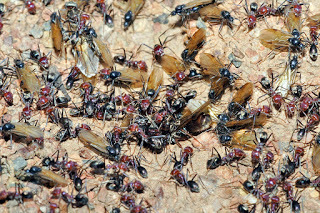 Winged ants swarming for nuptial flight (© fir0002/flagstaffotos.com.au/Wikipedia –
GFDL 1.2 licence
)
Winged ants swarming for nuptial flight (© fir0002/flagstaffotos.com.au/Wikipedia –
GFDL 1.2 licence
)However, it just so happens that nuptial flights of winged ants often take to the air shortly after thunderstorms - weather conditions that give rise to very strong atmospheric electrical fields. Under such conditions, it is quite likely that the swarms would indeed glow, and with a light strong enough to be easily observable at night. In addition, swarming winged ants may even create their own static electricity by rubbing together while in flight. So perhaps some UFO reports on record were inspired by swarms of flying ants after all. In a similar vein, moreover, Novitt also suggested that certain UFOs may be floating masses of gossamer (spider silk) carried aloft by the wind that sparkle and glow with static electricity, thereby echoing theories regarding the phenomenon of angel hair.
Dr Leonard Loeb, a former professor of physics at the University of California, has opined that Novitt's theories are: "interesting, original, and perhaps true". Loeb estimated that a fully-loaded swarm of 30 million flying ants could flicker intermittently for periods of more than a second in unfavourable conditions, or up to nearly a minute in favourable environments.
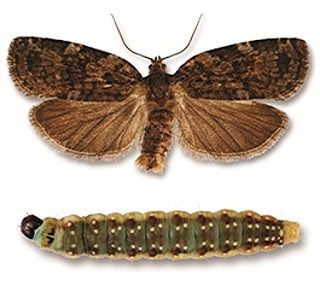 Spruce budworm moth and caterpillar (© Natural Rsources Canada, reproduced here on a strictly non-commercial Fair Use basis only)
Spruce budworm moth and caterpillar (© Natural Rsources Canada, reproduced here on a strictly non-commercial Fair Use basis only)A few UFOs may have involved swarms of moths. In a paper published by the journal Applied Opticsin 1978, insect behaviouralists Drs Philip Callahan and R.W. Mankin from the U.S.A. provided independent support for Novitt's findings by revealing that light can be generated by placing specimens of North America's spruce budworm moth Choristoneura fumiferana in electrical fields. This discovery confirmed that during those weather conditions when the air is heavily charged with electricity, insects are capable of emitting light.
Of course, the amount emitted by each insect would be minute, but as migrating swarms of spruce budworm moths can measure up to 60 miles long and 15 miles wide, the total amount of light emitted per swarm would be of very appreciable magnitude - more than enough, surely, to mimic a glowing UFO. And as Callahan and Mankin pointed out, it is noticeable that a number of UFO sightings of this latter type that they have analysed occurred at times when mass migrations of this moth species would be expected. In February 1979, a short coverage of their findings was published by the scientific journal Nature, in which it was mentioned that the then-current UFO wave in Uintah Basin, Utah, USA, might be due to swarms of flying insects emitting a corona discharge, i.e. an electrical discharge caused by the ionisation of the air surrounding their electrically-charged bodies when in flight.
This ShukerNature blog article is adapted from my book Mysteries of Planet Earth: An Encyclopedia of the Inexplicable .
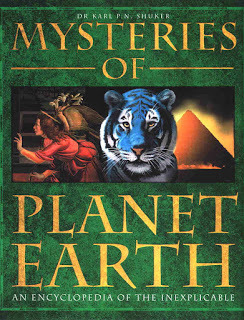
Published on February 03, 2017 20:25
January 31, 2017
MAKING A MOCKERY OF THE MOCK TURTLE NO LONGER – ELUCIDATING LEWIS CARROLL'S LUGUBRIOUS CALF-HEADED CHELONIAN
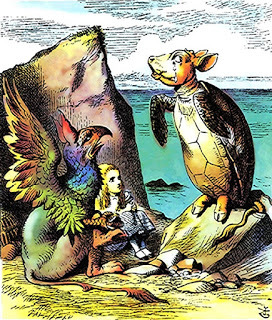 A colourised version of one of Sir John Tenniel's famous original illustrations of the Mock Turtle with the Gryphon and Alice, from Alice's Adventures In Wonderland, 1865 (public domain)
A colourised version of one of Sir John Tenniel's famous original illustrations of the Mock Turtle with the Gryphon and Alice, from Alice's Adventures In Wonderland, 1865 (public domain)Written by Lewis Carroll (the pen name of a socially shy Oxford University mathematician called Charles Lutwidge Dodgson), and originally published in 1865, one of my favourite childhood novels was Alice's Adventures In Wonderland (or Alice In Wonderland, to call it by its nowadays more commonly used shortened title). As is universally known, it was based upon an impromptu story told by Carroll to family friend Dean Henry Liddell's three young daughters one summer afternoon in July 1862 while he and the Reverend Robinson Duckworth were taking them on a rowing-boat ride along the Isis river (part of the Thames) not far from their home.
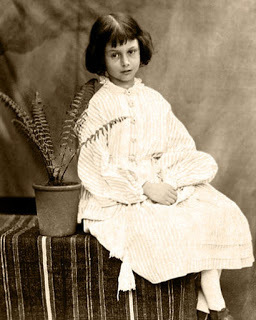 Photographed by Lewis Carroll in 1860, Alice Liddell as a 7-year-old child, the child who would later inspire Alice's Adventures In Wonderland (public domain)
Photographed by Lewis Carroll in 1860, Alice Liddell as a 7-year-old child, the child who would later inspire Alice's Adventures In Wonderland (public domain)One of the children was Alice Liddell, aged 10 at that time, whom Carroll made the heroine of the story after she'd asked him to tell them one that featured her in it. At the end of their boat ride, Alice begged Carroll to write the story down for her so that she would always have it, and so that same evening he duly began drafting out what would become three years later one of the best-loved children's novels of all time. Moreover, it would be followed in 1871 by an equally popular Alice-starring sequel, Through the Looking-Glass and What Alice Found There(which I actually liked even more than the first novel).
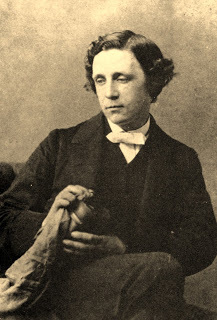 Lewis Carroll, photographed in 1863, just two years before the publication of his now-immortal children's novel (public domain)
Lewis Carroll, photographed in 1863, just two years before the publication of his now-immortal children's novel (public domain)Very fond of literary nonsense, witticisms, riddles, puns, and other word play, Carroll included many such examples in both of his Alice books. And as someone who read them countless times as a child and has always derived comparable pleasure from verbal drolleries, I greatly enjoyed spotting and making sense of them.
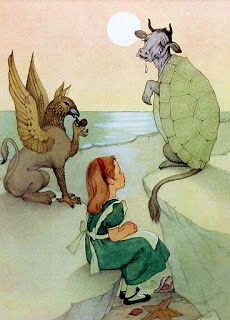 The first picture of the Mock Turtle that I ever saw, from my much-loved Marjorie Torrey-illustrated Alice In Wonderland book that my mother Mary Shuker bought for me when I was a very small child (© Marjorie Torrey/Random House – included here on a strictly non-commercial Fair Use basis only)
The first picture of the Mock Turtle that I ever saw, from my much-loved Marjorie Torrey-illustrated Alice In Wonderland book that my mother Mary Shuker bought for me when I was a very small child (© Marjorie Torrey/Random House – included here on a strictly non-commercial Fair Use basis only)However, there was one example that not only delighted me due to the fact that it concerned a seemingly fictitious creature that I'd never heard of before (even as a child, mysterious monsters and mythical beasts always fascinated me – clearly a cryptozoologist in the making!), but also had long mystified me. This was because I felt quite sure that its unusual name and even more unusual form embodied more significance than I had perceived as a child, yet I couldn't decide just what that significance might be. Appearing towards the end of the first Alice novel (or AAIW, for short, as used hereafter in this article), in tandem with an example of that very famous legendary beast the griffin (or gryphon, a more classical spelling, used by Carroll in that book), the perplexing creature in question was referred to by Carroll as a mock turtle.
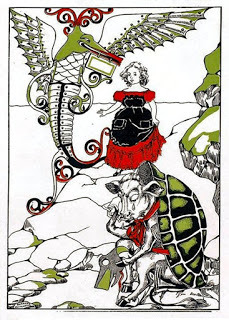 An exquisite Art Nouveau-inspired portrayal of the Mock Turtle and Gryphon, by Blanche McManus, 1899 (public domain)
An exquisite Art Nouveau-inspired portrayal of the Mock Turtle and Gryphon, by Blanche McManus, 1899 (public domain)In Carroll's account of the Gryphon and the Mock Turtle that the Queen of Hearts had taken Alice to meet, nothing of note concerning the morphology of either of them was included by him (devoting much of his coverage instead to their reciting and performing the Lobster Quadrille, a most unusual dance). Instead, all such details were imparted to the reader entirely by way of some excellent line drawings prepared by the renowned illustrator Sir John Tenniel working in strict accordance with Carroll's very exacting instructions. Carroll had initially planned to illustrate the book himself, and did so in a preliminary, then-unpublished, handwritten version entitled Alice's Adventures Under Ground (AAUG), which he presented to Alice Liddell on 26 November 1864. However, he recognised that his artistry was not of a sufficiently high standard for publication purposes, so he engaged Tenniel to prepare the required artwork for the final, longer version that became AAIW. (This was evidently a wise decision, judging at least from Carroll's bizarre illustration of the Mock Turtle that appeared in AAUG, in which its head resembled that of a seal, and its long, slender body looked as if it were composed entirely of overlapping roof tiles!)
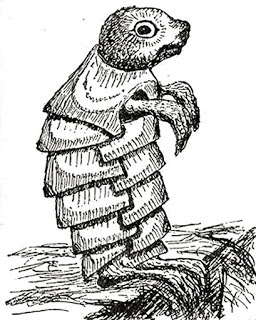 Lewis Carroll's decidedly odd-looking drawing of the Mock Turtle, from Alice's Adventures Under Ground (public domain)
Lewis Carroll's decidedly odd-looking drawing of the Mock Turtle, from Alice's Adventures Under Ground (public domain)In Tenniel's drawings, the Gryphon was depicted in typical griffin form, as a composite of eagle and lion, deftly amalgamating the beaked head, taloned forelimbs, and plumed wings of the former with the furry body, clawed hind limbs, and long tuft-tipped tail of the latter. Conversely, whereas the Mock Turtle also appeared to be a composite creature, it did not resemble anything known to me from either fable or fact. Nor had I even heard of a mock turtle before. Evidently, therefore, I reasoned, unless it were an exceedingly obscure mythical beast it must have been one of Carroll's own inventions, but what had inspired him to fashion it in the extraordinary form that he had done, and where had its very distinctive, memorable name originated? These were the two questions that puzzled me for so long (back in those now far-distant days before the information super-highway of the internet had come into being!).
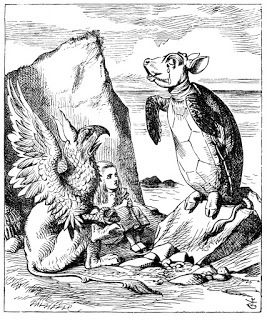 Sir John Tenniel's most famous depiction of the Mock Turtle and Gryphon, 1865 (public domain)
Sir John Tenniel's most famous depiction of the Mock Turtle and Gryphon, 1865 (public domain)For in Tenniel's illustrations, this remarkable creature was portrayed with the familiar body shell and scaly front flippers of a real turtle, but sported the big-eared head, hoofed hind legs, and long tufted tail of a calf. In my youthful naivety, I simply assumed that the 'mock' aspect of its name related to the fact that because of these bovine attributes it wasn't a genuine turtle, with the latter attributes merely being humorous but hardly meaningful creations by Carroll. I now know of course that had I been alive during Victorian times when AAIW was written and published, I would have been readily aware of the true derivation of this term and the attendant significance of those attributes – especially as, albeit unrealised by me back in my childhood, Carroll had actually provided the answer to one of my afore-mentioned questions in his text:
Then the Queen left off, quite out of breath, and said to Alice, "Have you seen the Mock Turtle yet?"
"No," said Alice. "I don't even know what a Mock Turtle is."
"It's the thing Mock Turtle Soup is made from," said the Queen.
"I never saw one, or heard of one," said Alice.
Neither had I, but nor had I ever heard of mock turtle soup either, so I had assumed that this too was just another Carrollian invention. Many years later, however, I finally stripped bare the mystery surrounding the 'mock' moniker, and uncovered at last the truth behind this very tantalising turtle.
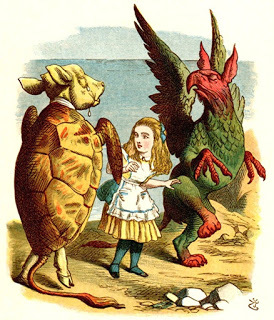 A colourised version of Tenniel's second original illustration of the Mock Turtle and Gryphon with Alice, 1865 (public domain)
A colourised version of Tenniel's second original illustration of the Mock Turtle and Gryphon with Alice, 1865 (public domain)It turned out that mock turtle soup was actually a bona fide dish, an English soup originally created during the mid-1700s but very commonly served in Victorian times. It earned its name from the fact that it was actually a cheap substitute for genuine turtle soup, which was a very expensive delicacy that few could afford. Instead of containing turtle flesh as its primary ingredient, mock turtle soup contained calf meat (veal), taken especially from those parts of a calf that were otherwise usually discarded, i.e. the head, hooves, and tail, and which therefore cost a lot less to produce than real turtle soup.
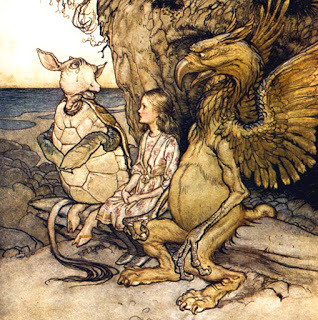 Classic illustration by Arthur Rackham of the Mock Turtle, Gryphon, and Alice, 1907 (public domain)
Classic illustration by Arthur Rackham of the Mock Turtle, Gryphon, and Alice, 1907 (public domain)Suddenly, all became clear. His fondness for humorous word games, puns, and other literary trickery had clearly inspired Carroll to dream up a character that was then playfully put forward by him when recounting his story as the (non-existent) creature from which was derived a certain very common veal-containing dish from his time whose memorable name would be familiar to his young listeners and thus make them laugh – namely, mock turtle soup. That was why the Mock Turtle had a turtle's shell and front flippers but a calf's head, hind limbs, and tail – with typically witty Carrollian absurdity, it was the visual embodiment of what mock turtle soup pretended to contain (turtle) and what it actually did contain (the calf elements listed above).
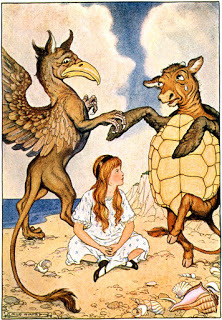 In this illustration from 1916, the Gryphon and a particularly tearful Mock Turtle perform the Lobster Quadrille for a somewhat bemused Alice (public domain)
In this illustration from 1916, the Gryphon and a particularly tearful Mock Turtle perform the Lobster Quadrille for a somewhat bemused Alice (public domain)One further feature that was a major component of the Mock Turtle was its extremely lugubrious, sobbing demeanour. When Alice asked the Gryphon why his chelonian companion was so sorrowful, the Gryphon replied very dismissively that it was "all his fancy", that he didn't actually have any sorrow. Yet because the Mock Turtle briefly mentioned that he had once been a real turtle (but without providing any clues as to why he no longer was), there has been much speculation among Carrollian scholars as to whether this was the reason for his tearful melancholia, coupled perhaps with what may have been a poverty-stricken upbringing (when recounting his history to Alice, the Mock Turtle intimated that he was poor when young, revealing that he couldn't afford to study any extra subjects at school, only the regular ones).
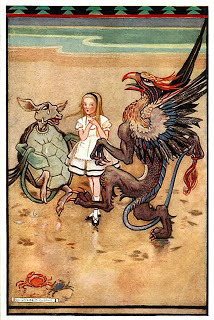 The Mock Turtle is no less mournful in this illustration either, by Gwynedd Hudson, 1922, but Alice looks distinctly perturbed by their terpsichorean exuberance! (public domain)
The Mock Turtle is no less mournful in this illustration either, by Gwynedd Hudson, 1922, but Alice looks distinctly perturbed by their terpsichorean exuberance! (public domain)As a wildlife enthusiast from the earliest of ages, however, it occurred to me a long time ago that a more likely origin for this particular characteristic of the Mock Turtle was that real turtles, which are all exclusively marine in the strict definition of the term 'turtle' traditionally employed in British English, rid their bodies of excess salt (derived from drinking seawater) by excreting it in the form of salty tear-like exudation trickling from glands near to their eyes, so that they look very much as if they are weeping profusely. Quite apart from being a mathematician and storyteller, Carroll was also a keen amateur naturalist (and is known to have made a particular study of those animals featuring in his Alice novels to ensure that his accounts of them were accurate). Consequently, he was assuredly aware of this specific behavioural occurrence in turtles, and had cleverly incorporated it with altered meaning into the Mock Turtle's persona, transforming it from a practical osmoregulatory activity into an entirely anthropomorphic emotional outpouring instead.
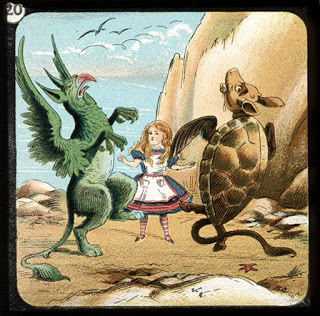 The Mock Turtle managed to be doleful even when dancing, as seen here in this lantern slide image from the early 1900s (public domain)
The Mock Turtle managed to be doleful even when dancing, as seen here in this lantern slide image from the early 1900s (public domain)More than 150 years have passed since the Mock Turtle was introduced to the world in AAIW, and it has been depicted by over 70 artists within the numerous illustrated editions that have been published since the original one from 1865, containing Tenniel's drawings. It has also appeared in a considerable number of films and TV adaptations (in which it has been played by the likes of Cary Grant, Sir John Gielgud, Sir Michael Hordern, Donald O'Connor, Gene Wilder, and Ringo Starr, as well as being voiced by Alan Bennett in the 1985 film Dreamchild).
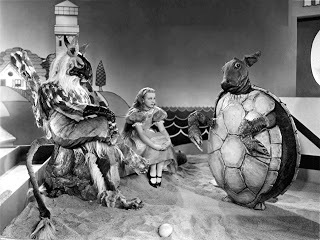 The Gryphon, Mock Turtle, and Alice (played by Viola Savoy) in a photo-still from Alice In Wonderland (1915), a very early silent film version written and directed by W.W. Young, and viewable online here (public domain)
The Gryphon, Mock Turtle, and Alice (played by Viola Savoy) in a photo-still from Alice In Wonderland (1915), a very early silent film version written and directed by W.W. Young, and viewable online here (public domain)What is particularly interesting, however, is that whereas earlier portrayals generally retained its appearance as originated by Tenniel following Carroll's instructions to him, there have been various later depictions that have strayed significantly from this. Moreover, the way in which they have strayed seems to indicate that those responsible may not have realised why this character's appearance was what it was in the original book, thereby, albeit inadvertently, making a veritable mockery of the Mock Turtle.
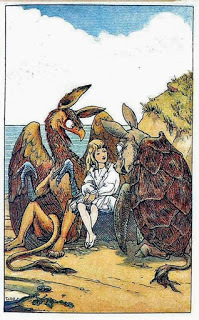 An illustration from 1907 by W.H. Walker featuring an accurately-depicted Mock Turtle but a very predatory-looking Gryphon in worryingly close proximity to Alice! (public domain)
An illustration from 1907 by W.H. Walker featuring an accurately-depicted Mock Turtle but a very predatory-looking Gryphon in worryingly close proximity to Alice! (public domain)The reason for my suspecting this to be the case is that the Mock Turtle has sometimes been depicted not as a half-turtle half-calf composite, but merely as a normal, ordinary turtle, with not just a body shell but also a turtle's head, hind flippers, and tail – thereby entirely missing the etymological significance and origin of this Carrollian character. After all, if the Mock Turtle is presented as being exactly the same in appearance as a genuine turtle, how can the term 'mock' be justifiably applied to it? Equally, the crucial fact that it was specifically created by Carroll as the creature from which mock turtle soup is supposedly derived is wholly concealed visually if it is depicted simply as a totally normal-looking turtle. In a different but no less bizarre vein, I have also seen the Mock Turtle portrayed with the head, trotters, and curly tail of a pig, which if anything makes even less sense than depictions of it as a genuine turtle!
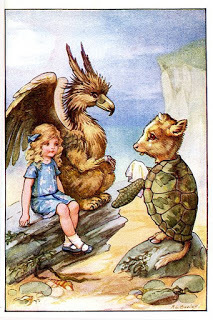 An unusual but thoroughly charming illustration from 1926 by A.L. Bowley, in which not only Alice but also apparently both the Mock Turtle and the Gryphon are depicted as youngsters (public domain)
An unusual but thoroughly charming illustration from 1926 by A.L. Bowley, in which not only Alice but also apparently both the Mock Turtle and the Gryphon are depicted as youngsters (public domain)Today, the Mock Turtle's fame stretches far beyond the confines of Carroll's beloved novel, appearing in a number of works by other authors inspired by Wonderland and its many strange but memorable inhabitants. As noted earlier, it features in many movie and TV dramatisations of AAIW too, as well as in various songs, and it has even lent its name to a popular Indie rock band, The Mock Turtles, hailing from Greater Manchester, England.
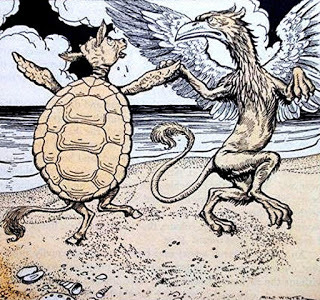 Still more dancing, but no sign of Alice in this illustration from 1928 – perhaps she'd become bored of it all by now and went home! (© Copyright holder and original source of this illustration presently unknown to me – reproduced here on a strictly non-commercial Fair Use basis only)
Still more dancing, but no sign of Alice in this illustration from 1928 – perhaps she'd become bored of it all by now and went home! (© Copyright holder and original source of this illustration presently unknown to me – reproduced here on a strictly non-commercial Fair Use basis only)Nevertheless, at least for me there is one major disappointment associated with this memorable character – that it didn’t appear in Walt Disney's very colourful, classic animated film, Alice in Wonderland, first released in 1951. Very recently, however, I was most interested to discover that in fact, along with the Gryphon, the Mock Turtle had indeed been due to feature in it. In fact, cartoon versions of their characters had been produced, and were scheduled to appear in one scene, with the Mock Turtle even singing two specially-penned songs ('Beautiful Soup', sung to the tune of 'The Blue Danube', and 'Will You Join The Dance?', based upon the 'Lobster Quadrille' poem recited by this character in the novel'). Just before the film's completion, however, their scene and songs were axed. Happily, though, all was not entirely lost, because later on in the 1950s Disney produced an animated Wonderland-based commercial for Jell-O gelatin desserts in which the Mock Turtle and Gryphon did feature, together with Alice.
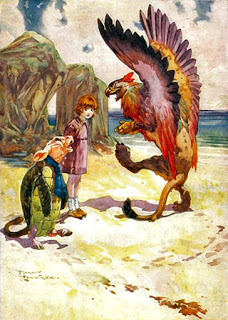 A very beautiful, colourful rendition of the Mock Turtle, Alice, and a fiery-plumed Gryphon by Harry Rountree, 1928 (© Harry Rountree, reproduced here on a strictly non-commercial Fair Use basis only)
A very beautiful, colourful rendition of the Mock Turtle, Alice, and a fiery-plumed Gryphon by Harry Rountree, 1928 (© Harry Rountree, reproduced here on a strictly non-commercial Fair Use basis only)Even so, failing to make the final cut in one of Disney's most delightful animated films would be enough, surely, to make anyone cry, let alone someone as famously weepy as the mournful Mock Turtle!
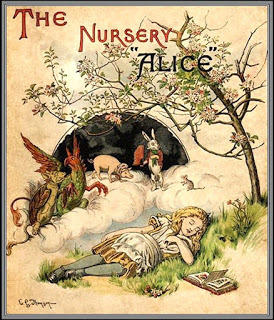 The Nursery "
Alice
"
– a special edition of AAIWfor very young children, simplified by Lewis Carroll and illustrated by Sir John Tenniel; it was published in 1890 and included both the Mock Turtle and the Gryphon on its front cover, prepared by one of Carroll's friends, E. Gertrude Thomson (public domain)
The Nursery "
Alice
"
– a special edition of AAIWfor very young children, simplified by Lewis Carroll and illustrated by Sir John Tenniel; it was published in 1890 and included both the Mock Turtle and the Gryphon on its front cover, prepared by one of Carroll's friends, E. Gertrude Thomson (public domain)To read a previous ShukerNature blog article concerning another of my favourite AAIW animal characters, the iconic and decidedly idiosyncratic Cheshire Cat, please click here .
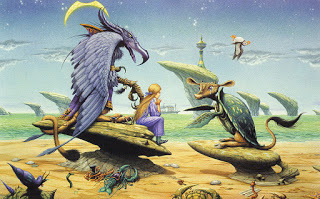 One of my all-time favourite AAIW-inspired artworks, an absolutely spectacular and very original futuristic/fantasy take on the Mock Turtle, Gryphon, and Alice, by the world-renowned fantasy artist Rodney Matthews (© Rodney Matthews, included here on a strictly non-commercial Fair Use basis only)
One of my all-time favourite AAIW-inspired artworks, an absolutely spectacular and very original futuristic/fantasy take on the Mock Turtle, Gryphon, and Alice, by the world-renowned fantasy artist Rodney Matthews (© Rodney Matthews, included here on a strictly non-commercial Fair Use basis only)
Published on January 31, 2017 10:25
January 30, 2017
SHEDDING LIGHT ON (AND BY) THE SEA MOUSE - FURRY BODY BUT LOTS OF LEGS!
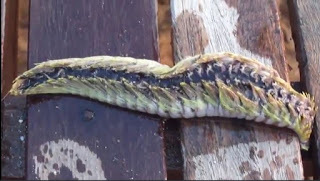 Photo-still from online video clip whose 'mystery creature' is simply a species of polychaete worm, quite probably allied to the sea mouse (© ownership of video clip currently unknown to me – photo-still included here on a strictly non-commercial Fair Use basis only)
Photo-still from online video clip whose 'mystery creature' is simply a species of polychaete worm, quite probably allied to the sea mouse (© ownership of video clip currently unknown to me – photo-still included here on a strictly non-commercial Fair Use basis only)In recent times, several correspondents have drawn my attention to a brief video clip in gif format circulating widely online (view it here , for instance, where it was posted on 4 September 2016). The source of the photo-still that opens this present ShukerNature blog article, the video clip showcases in close-up a most intriguing sea creature, not very big but very distinctive nonetheless. No information accompanies the clip, however, so what could the animal be? Many different identities have been proposed online, some decidedly imaginative, but in reality this putative cryptid is merely a polychaete worm, and may well be allied to a particular favourite one of mine - namely, a certain many-legged mouse mimic from the marine world, and to which the remainder of this article is now devoted.
In stormy weather, the sea may throw up onto coastal beaches a truly amazing little saltwater denizen that often fools the unwary observer. At first sight, it resembles a large, fat, wet mouse, around 4-8 inlong and 3 inwide, covered in what looks like soft greyish-brown fur. And as it creeps across the sand, it moves quite like a mouse too. Yet closer observation will reveal that it does not have any kind of readily recognisable head. Nor does it have a real mouse's familiar long thin tail.
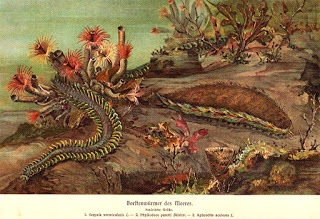 German colour plate from 1922 illustrating various marine worms, including a sea mouse (right) (public domain)
German colour plate from 1922 illustrating various marine worms, including a sea mouse (right) (public domain)The biggest surprise will come, however, if the observer should attempt to pick up this animal, because if he does, and then turns it over onto its back, an incredible surprise will be exposed. Instead of having just four legs, this amazing animal has lots and lots - all in pairs that run down the whole length of its body. Moreover, it has a pair of short tentacles at the front of its body, and its two eyes are on stalks.
For this is not a mouse at all, but is actually a truly extraordinary type of polychaete sea worm. Instead of being long and very thin like many such worms, however, it is squat and fat, and because of its deceptively mouse-like fur and movements, it is known scientifically as the sea mouse. There are many species, most of which belong to the genus Aphrodita, and frequently occur in the North, Mediterranean, and Baltic Seas, and in the Atlantic Ocean. The most familiar species, and the one described and dealt with predominantly by me here, is the common sea mouse Aphrodita aculeata, which is regularly encountered around Britain's coasts. Also well known is the southern sea mouse A. australis, but this aptly-named species exists much further afield, being native to coastal waters around southern Australia and New Zealand.
 Southern sea mice – one displayed ventrally (above), the other one dorsally (below) (public domain)
Southern sea mice – one displayed ventrally (above), the other one dorsally (below) (public domain)Belonging to the polychaete class of annelids or segmented worms, the sea mouse's closest relatives include the lugworm, the fanworms, and the many-legged ragworms that live in the sea, and under normal conditions it lives in burrows in shallow coastal waters, but some specimens have also been found at depths of almost 10,000 ft. And whereas mammalian mice are generally herbivorous, this marine namesake is an active nocturnal carnivore, remaining half-buried in sand and devouring unsuspecting small crabs and even other polychaete worms that stray within its predatory reach, including specimens much longer than itself.
As for the sea mouse's 'fur', this is actually a mass of soft felt-like bristles called setae, covering several pairs of scales that in turn cover its back. These scales protect its gills, with which it breathes, extracting oxygen from water pumped by its own muscular activity into its burrow, and the setae prevent the gills from becoming clogged with sand. The setae at the edges of the sea mouse's body are normally deep-red, not greyish-brown like those on its back, but they will gleam brightly with vivid blue and green stripes whenever sunlight falls directly upon them – a spectacular structural colouration effect achieved by numerous hexagonal cylinders within these peripheral setae, and performing far more efficiently than man-made optical fibres, as revealed by research published in 2012. Moreover, this very eyecatching activity in turn constitutes a highly effective defence mechanism, because it startles and thereby warns off potential predators of the sea mouse – all of which is something that not even the fur of the cleanest mammalian mouse can ever accomplish!
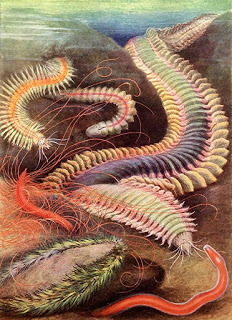 Beautiful colour illustration by okapi-discoverer Sir Harry Johnston depicting a selection of marine worms, including a sea mouse at the bottom-left corner, from Marvels of the Universe, Vol. 2 (1927) (public domain)
Beautiful colour illustration by okapi-discoverer Sir Harry Johnston depicting a selection of marine worms, including a sea mouse at the bottom-left corner, from Marvels of the Universe, Vol. 2 (1927) (public domain)
Published on January 30, 2017 08:59
January 22, 2017
AFTER EIGHT YEARS OF SHUKERNATURE THE BLOG, A FIRST GLIMPSE OF SHUKERNATURE: THE BOOK!
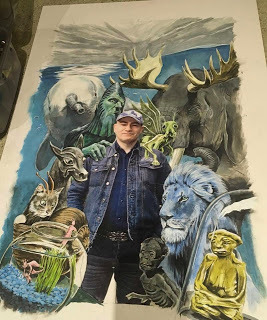 Early version of Anthony Wallis's awesome front-cover artwork for ShukerNature: The Book – thanks, Ant!! (© Anthony Wallis/Dr Karl Shuker)
Early version of Anthony Wallis's awesome front-cover artwork for ShukerNature: The Book – thanks, Ant!! (© Anthony Wallis/Dr Karl Shuker)Due to some recurrent internet-connection problems during the past few days, I omitted to mark a memorable day in the history of my ShukerNature blog – its eighth anniversary, which occurred on 20 January 2017. So, better late than never, I am doing so now – by presenting herewith the very first sneak preview of my next book, which is none other than the long-awaited, long-promised compendium of some of my blog's most unusual and popular articles. Or, to put it another way – welcome to ShukerNature: The Book .
My blog was scarcely two years old when, after asking among my many Facebook friends and colleagues whether a compilation volume of some of my blog articles would be of interest to them, I received a resoundingly positive response. And so I began planning it accordingly, alongside various other writing projects. However, as sometimes happens, life – and death – had other plans for the direction in which my future would take. Or, as my wise little Mom used to remind me gently if I railed against my dreams and ambitions faltering or falling into disarray: "Man proposes, but God disposes" (which is a translation of the Latin phrase 'Homo proponit, sed Deus disponit', from Book I, chapter 19, of The Imitation of Christ by the German cleric Thomas à Kempis).

And so it was that my ShukerNature book was set to one side, and other projects that for one reason or another needed to take precedence were duly completed and published in its stead. Notable among these were my second, long-planned, and extremely comprehensive dragons book – Dragons in Zoology, Cryptozoology, and Culture ; a wide-ranging compilation of my most notable Loch Ness monster writings – Here's Nessie! ; and of course my massively-enlarged, fully-updated prehistoric survivors book – Still In Search Of Prehistoric Survivors .
These are all now published, and in the meantime the very many additional blog articles that I have continued to research, write, and post each year have provided me with an immensely expanded list of possible examples to include in my eventual ShukerNature compendium. And now, at last, much of this book is indeed written – all of the main text, in fact, barring any last-minute changes or additions – and it will be published later this year.
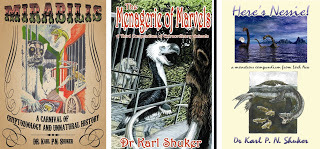
Moreover, I am both thrilled and delighted that its front cover artwork is being produced by none other than a longstanding Facebook friend who is also a brilliant artist – Anthony Wallis. I am very lucky that no fewer than three of my previous books' front covers are graced by spectacular artwork that has been either produced (two) or co-produced (one) by Ant. Namely, Mirabilis (2013), The Menagerie of Marvels (2014), and Here's Nessie! (2016) (this last-mentioned book's front cover featuring both a very vibrant long-necked seal reconstruction of Nessie by Ant and a beautifully evocative plesiosaurian monsters by moonlight scene by Wm Michael Mott).
So here, opening this present ShukerNature blog article as a first glimpse of ShukerNature: The Book , is an early version of Ant's wonderful front-cover artwork for it – thank you so much, Ant, for bringing to life so vividly and with such incredible skill a unparalleled diversity of obscure, hitherto-overlooked, but effortlessly spellbinding mystery beasts that will not be found together in any other book. And so, the countdown to its publication has begun – the wait will soon be over…
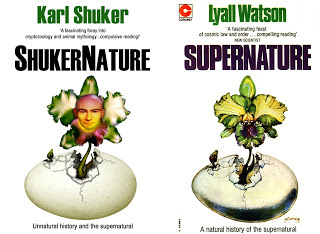 An affectionate illustrative pastiche (left) by another longstanding artist friend, Mark North, inspired by and in tribute to the classic front-cover artwork of the international non-fiction bestseller Supernature (right), written by Dr Lyall Watson and first published in 1973, whose title partly inspired the title of my blog – click
here
for more details (© Lyall Watson/Coronet Books / © Mark North)
An affectionate illustrative pastiche (left) by another longstanding artist friend, Mark North, inspired by and in tribute to the classic front-cover artwork of the international non-fiction bestseller Supernature (right), written by Dr Lyall Watson and first published in 1973, whose title partly inspired the title of my blog – click
here
for more details (© Lyall Watson/Coronet Books / © Mark North)
Published on January 22, 2017 16:19
January 8, 2017
AN INTERVIEW WITH THE CURIOUS FORTEAN
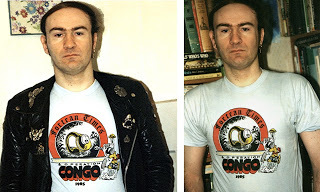 Wearing my Fortean Times-sponsored 'Operation Congo 1985' mokele-mbembe expedition t-shirt, whose wonderful m-m logo was created by FT's very own Hunt Emerson (© Dr Karl Shuker)
Wearing my Fortean Times-sponsored 'Operation Congo 1985' mokele-mbembe expedition t-shirt, whose wonderful m-m logo was created by FT's very own Hunt Emerson (© Dr Karl Shuker)I was recently interviewed by Matt Cook from The Curious Fortean on a wide range of interesting subjects – from classic cryptids such as Nessie and the Congolese mokele-mbembe to the little loriciferan that was named after me, the prestigious Golden Yeti awards bestowed upon me a month ago for my contributions to cryptozoology, and much else besides. You can read the interview in full here , on The Curious Fortean's blog, and also be sure to check out the official Facebook group for The Curious Fortean here .
My sincere thanks to Matt for interviewing me and for posing such a fascinating series of thoughtful, insightful questions.
Also, be sure to check out my two most recent books – Still In Search Of Prehistoric Survivors and Here's Nessie! A Monstrous Compendium From Loch Ness – both of which are referred to in this interview.
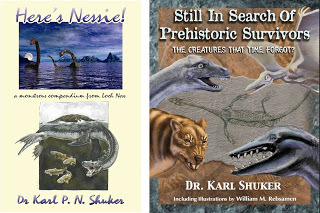
Published on January 08, 2017 07:00
December 31, 2016
ARE GIANT FLIGHTLESS RAVENS SOMETHING TO CROW ABOUT IN CANADA?
 Representation of the possible appearance of British Columbia's alleged red-tailed giant ravens (© Dr Karl Shuker)
Representation of the possible appearance of British Columbia's alleged red-tailed giant ravens (© Dr Karl Shuker)What better way for ShukerNature to begin 2017 than with a hitherto little-known mystery beast – so here is one right now!
On 28 March 2012, French cryptozoological correspondent Raphaël Marlière kindly brought to my attention the following intriguing report that he'd recently seen on the Cryptodominion website (click here ). It may well be mere folklore - then again, it just might be something more.
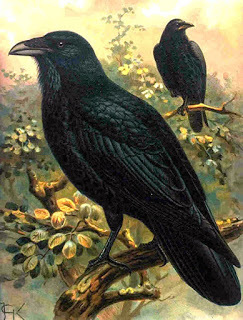 Normalravens (public domain)
Normalravens (public domain)According to Cryptodominion, loggers who have worked in the interior of British Columbia, Canada, assert that an isolated, timber-rich valley exists here that is inhabited by huge ravens, bigger even than golden eagles, but virtually flightless, and further distinguished from normal ravens Corvus corax by their tail plumage, which exhibits a noticeable amount of red pigmentation. Apparently, these mystery red-tailed mega-corvids are very dangerous and opportunistic, not hesitating to wreck a campsite.
Lumberjack folklore is renowned in North America for its tall tales of exotic fauna (variously dubbed fierce or fearsome critters) – everything from fur-bearing trout to spiky-furred cactus cats – so this may simply be a less familiar variant. Nevertheless, if anyone out there has any additional information concerning such birds, I'd be very interested to receive details.
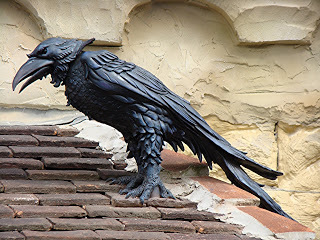 Elegant raven sculpture at the Raveleijn theatre in Efteling, a fantasy-based theme park at Kaatsheuvel, in the Netherlands (public domain)
Elegant raven sculpture at the Raveleijn theatre in Efteling, a fantasy-based theme park at Kaatsheuvel, in the Netherlands (public domain)
Published on December 31, 2016 18:55
December 28, 2016
DUPLICATING THE DIRE WOLF AS A DOMESTIC DOG?
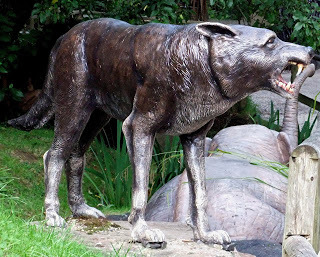 Life-sized dire wolf statue at Dinosaur Valley, Wookey Hole, in Somerset, England
(© Dr Karl Shuker)
Life-sized dire wolf statue at Dinosaur Valley, Wookey Hole, in Somerset, England
(© Dr Karl Shuker)
Closely related but larger than today’s grey wolf Canis lupus, the formidable North American dire wolf C. dirus is famous for the numerous specimens discovered in California’s La Brea Tar Pits, but it had become extinct around 10,000 years ago. However, there is a remarkable ongoing project dedicated to achieving a dramatic dire wolf resurrection...of sorts.
 Woodward's eagle Amplibuteo woodwardi (a giant North American raptor from the late Pleistocene) vs the dire wolf (© Hodari Nundu aka Justin Case)
Woodward's eagle Amplibuteo woodwardi (a giant North American raptor from the late Pleistocene) vs the dire wolf (© Hodari Nundu aka Justin Case)A fascinating breeding program that has been attracting plenty of media attention lately is the Dire Wolf Project (click here to visit its official website), launched by the National American Alsatian Breeder’s Association, because it aims to recreate within a domestic breed of companion dog the basic dire wolf body, size, and bone structure. In short, not a true, genetically-restored dire wolf, but rather a domestic dog that mirrors the dire wolf’s phenotype (external morphology) as closely as possible.
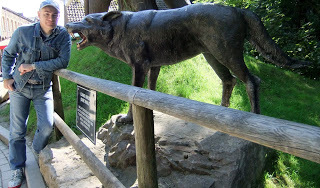 Alongside dire wolf statue at Dinosaur Valley, Wookey Hole, in Somerset, England, on 29 August 2010(© Dr Karl Shuker)
Alongside dire wolf statue at Dinosaur Valley, Wookey Hole, in Somerset, England, on 29 August 2010(© Dr Karl Shuker)The American Alsatian, first created in 1987 from matings between original Alsatians (German Shepherd Dogs) and Alaskan Malamutes and initially referred to as the North American Shepalute, is itself the first product of this selective breeding project. However, the project’s continuing long-term plan is to refine its morphology still further, ever increasing its outward similarity to the genuine dire wolf, having subsequently introduced Anatolian Shepherd Dogs, English Mastiffs, and the Great Pyrenees into the breeding mix, because each of these possesses certain morphological attributes recalling those of the dire wolf.
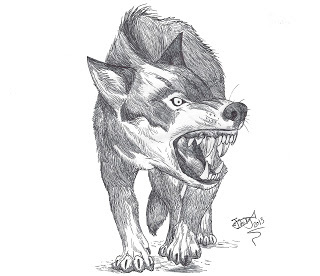 Artistic representation of a dire wolf (© Hodari Nundu aka Justin Case)
Artistic representation of a dire wolf (© Hodari Nundu aka Justin Case)Conversely, no dogs with any recent bona fide lupine ancestry have been used, because the goal is to restore or reconstitute the dire wolf in looks only – breeding back the large, round bones, the massive feet, and the broad head found in the skeletal structure of dire wolves studied by American palaeontologists – and not this wild prehistoric species’ behaviour or exact genetic composition. Nevertheless, a domestic dog duplicating the outward morphology of a bona fide dire wolf will still be a very impressive creature, to say the least. Consequently, it will be most interesting to monitor the progress of such a novel project, and see whether its intriguing goal is eventually accomplished. Watch this space!
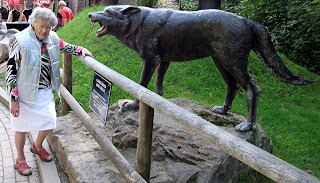 My mother Mary Shuker alongside a very realistic replica of a dire wolf, at Dinosaur Valley, Wookey Hole, in Somerset, England, on 29 August 2010 (© Dr Karl Shuker)
My mother Mary Shuker alongside a very realistic replica of a dire wolf, at Dinosaur Valley, Wookey Hole, in Somerset, England, on 29 August 2010 (© Dr Karl Shuker)
Published on December 28, 2016 09:38
December 26, 2016
ROSE HILL DAWGIE BLUES - THE PHANTOM BLUE MASTIFF OF MARYLAND
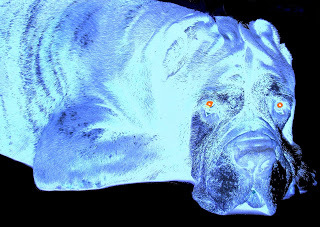 Does a huge phantom mastiff emitting an eerie blue phosphorescent glow haunt Rose Hill in the vicinity of Port Tobacco, Maryland, USA? (© Dr Karl Shuker)
Does a huge phantom mastiff emitting an eerie blue phosphorescent glow haunt Rose Hill in the vicinity of Port Tobacco, Maryland, USA? (© Dr Karl Shuker)Telling ghost stories during the Christmas season is a longstanding Yuletide festive tradition, so here is ShukerNature's contribution for Christmas 2016. But what makes this particular story very special is that its phantom protagonist may actually be real! The apparition in question is the blue ghost dog of Rose Hill, just outside Port Tobacco, a once-thriving seaport in Charles County, Maryland, USA.
According to local tradition, during the political unrest leading up to the American Civil War (or leading up to the American War of Independence, a century earlier, in some versions), a Yankee soldier-peddler called Charles Thomas Sims, accompanied by a huge mastiff-like tick hound with unusual blue-grey fur, sought warmth and shelter one very wintry 8 February at the St Charles Inn, one of many waterfront taverns in Port Tobacco at that time.
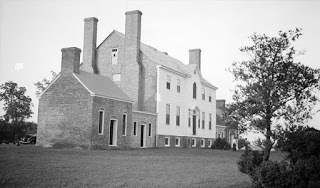 Rose Hill Manor (public domain)
Rose Hill Manor (public domain)Once inside, however, he soon became so intoxicated that he clumsily spilled a number of gold coins out of his purse. This attracted the keen attention of a gang of rough youths, led by a ne'er-do-well named Henry Hanos, who lost no time in luring him out of the inn and the town, leading him instead along Rose Hill Road and up to the vast grounds of Rose Hill Manor atop a lonely hill just outside Port Tobacco.
Here, securely out of sight of the town's populace, Hanos and his mob clubbed the hapless Sims and his dog to death on a big rock in the manor's grounds, near the roadside, and then stole his gold, burying it under a holly tree alongside the road on the hill for safekeeping, but planning to return later and retrieve it. When they did return, however, they were horrified to see a monstrous dog surrounded by an eerie blue phosphorescence howling on the rock, the site of its master's murder and its own too - and as soon as they tried to draw nearer, the dog raced towards them in hellish fury!
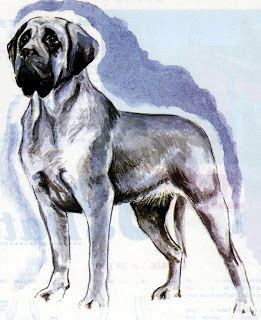 Artistic representation of the phantom blue mastiff of Rose Hill (© Unknown artist/All About Dogs, January-February 1998, reproduced here on a strictly non-commercial, educational/review Fair Use basis only)
Artistic representation of the phantom blue mastiff of Rose Hill (© Unknown artist/All About Dogs, January-February 1998, reproduced here on a strictly non-commercial, educational/review Fair Use basis only)Screaming with terror, the youths fled, never coming back, and Hanos swiftly fell ill, dying abruptly soon afterwards. Since then, several others have boldly ventured to Rose Hill to seek Sims's gold, including some troops of General Joseph Hooker fighting near here in the Civil War - but when confronted by the unearthly luminous blue dog, they have swiftly departed this accursed spot, leaving the gold untouched. Moreover, the former owner of Rose Hill Manor in whose grounds the killings allegedly took place, Olivia Floyd, an erstwhile Confederacy spy during the Civil War, claimed in an interview with the Port Tobacco Timesnewspaper in 1897 to have once seen the great glowing hound there herself – the earliest written documentation of it.
Today, the blue ghost dog is very much a local celebrity in Port Tobacco, which is home to an ornate sign depicting it and even boasts a Blue Dog Saloon containing a huge and very beautiful oil painting by local artist Don Zimmer portraying the tragic scene of the slain Sims lying dead amid a desolate snowy landscape and the teary-eyed ghost of his faithful dog lying close by. Moreover, prints of this magnificent painting can actually be purchased, with all proceeds going towards the Nanjemoy Neighbors Water Project (click here to visit the official website at which to buy a print of the painting).
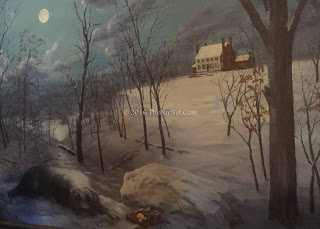 Magnificent oil painting portraying the tragic death scene from the legend of the Rose Hill blue ghost dog (© Don Zimmer/TheBayNet.Com 2016 – reproduced here on a strictly non-commercial, educational/review Fair Use basis only)
Magnificent oil painting portraying the tragic death scene from the legend of the Rose Hill blue ghost dog (© Don Zimmer/TheBayNet.Com 2016 – reproduced here on a strictly non-commercial, educational/review Fair Use basis only)The legend of the blue ghost dog of Rose Hill is often stated to be the oldest ghost story in the entire USA, but is it more than just a local folktale? And, if so, are sightings of this terrifying canine apparition still occurring today? (I've read claims that sightings have reputedly occurred as recently as the 1970s, and most frequently during the month of February, but with no details supplied.)
I have no idea of the answers to these questions, so what I'm going to do now is what I always do in situations like this. Namely, request that if anyone reading my present ShukerNature article has further information concerning its subject, and especially any details regarding possible modern-day encounters with the phantom dog itself, please do post them here, as I'd be very interested indeed to receive and read them. Thanks very much!
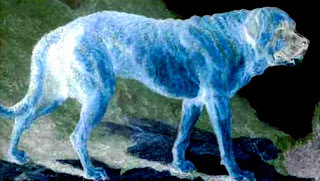 Could the phantom blue mastiff of Rose Hill look something like this? (© Dr Karl Shuker)
Could the phantom blue mastiff of Rose Hill look something like this? (© Dr Karl Shuker)
Published on December 26, 2016 22:19
Karl Shuker's Blog
- Karl Shuker's profile
- 45 followers
Karl Shuker isn't a Goodreads Author
(yet),
but they
do have a blog,
so here are some recent posts imported from
their feed.



